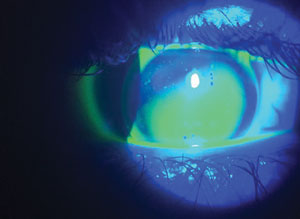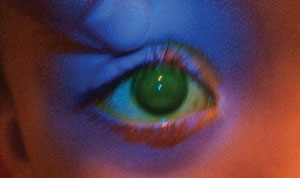 |  |
 |
| Too steep a fit results in inferior decentration and accummulation of bubbles underneath the lens. |
Post cataract surgery, eye care providers face the challenge of finding the proper refractive correction to reduce the risk of amblyopia. If sufficient capsular support is present, intraocular lens (IOL) implantation can be performed once the patient is two years of age.4 However, contact lenses can be fit on infants and may even be a preferable long-term option. The Infant Aphakia Treatment Study Contact Lens Experience, which compared contact lens correction for unilateral aphakia with IOL implantation for children between one and six months of age, showed visual acuity outcomes were similar at age one and four and a half.4 The rate of adverse events was lower in the study’s contact lens wearers, and few patients in that group required additional intraocular procedures.4
These outcomes demonstrate that contact lenses are a viable option for managing aphakia—and rushing into IOL implantation is not always the right answer for patients who are less than ideal candidates.
Choosing a Lens
Silicone elastomer soft contact lenses are commonly used in the early treatment of aphakia; however, they present challenges that may be exacerbated when treating the pediatric population: (1) while highly permeable to oxygen, they are prone to surface deposits, (2) limited power and fitting parameters can make it difficult to properly manage a patient and (3) financial costs associated with contact lens replacement, either due to power changes or lens loss, can result in poor compliance and follow up.
Gas permeable (GP) lenses are a great resource for managing aphakic infants. Due to infants’ small corneal diameter and narrow lid fissures, they can easily tuck underneath the taut lids and stay in place.5 They are available in a wide range of prescriptions and can be customized to the desired power and base curve. They are durable and simple to handle, often making it easier on parents to insert and remove.
Although GP lenses provide the least incidence for microbial keratitis, lens loss and ocular irritation tend to be the most common issues with this lens material.5,6
 |
| This well-centered GP lens shows good apical alignment. |
Fitting GPs for Aphakia
Because most patients are initially examined under anesthesia, corneal measurements, keratometry values and a refraction by retinoscopy should be available prior to the contact lens fitting appointment. When fitting a patient in GP lenses, clinicians should select a base curve that is 1mm to 1.5mm steeper than the flattest keratometry reading—a value based off the Infantile Aphakia Treatment Study Protocol.8 Evaluating the fluorescein pattern may lead to a change in base curve. The overall lens diameter is usually 10mm or larger, although this can vary depending on the patient’s corneal diameter. The optimal fitting lens displays a well centered alignment fit, with adequate edge clearance evidenced by an approximately 1mm band of fluorescein around the lens edge.7 Topical anesthetics to facilitate the contact lens fitting evaluation, and during insertion and removal training are typically not required, because the child’s fear is usually what makes these fits difficult, not lens awareness.8
Once clinicians determine the appropriate cornea-to-lens relationship, they can refine lens powers by retinoscopy over the diagnostic lens. In children under the age of two, 2D to 3D of additional plus are added to the lens to provide clear near vision. Spare lenses should be provided in the event the contact lens is lost to allow continued optical correction to prevent amblyopia.8
Correction After Two
Bifocal lenses are prescribed for the child around age two, when the added power of over-plussed lenses begins to interfere with distance viewing.8 Often, the GP lens is made for full distance correction, and the clinician then prescribes overlay bifocal spectacles with a +3.00 add power. Choosing bilateral or unilateral bifocals is often left to the clinician’s preference.
Generally speaking, if a patient has unilateral aphakia, unilateral bifocals are prescribed to allow the phakic eye to accommodate freely without creating unnecessary blur. Progressive lenses can also be used if the patient has bilateral aphakia.
| Case Example |
| A two-month-old female patient was referred for a contact lens evaluation following cataract extraction. The patient presented wearing a Silsoft Super Plus (Bausch + Lomb) 7.5 base curve, 11.3 overall diameter (OAD) and +32.00D power—inserted by her cataract surgeon for extended wear until she could be seen by a specialty contact lens fitting optometrist. At the first contact lens visit, retinoscopy showed a +4.50D over-refraction. Examining the contact lens fit using a 20D lens and transilluminator revealed adequate centration, good movement and full corneal coverage. Although an adequate fit, the Silsoft contact lens has a maximum power of +32.00D, and a GP contact lens was considered in the near future. The parents were trained on insertion and removal of the soft contact lens and advised to remove the lens each night and clean it with a hydrogen peroxide solution. An online video on insertion and removal was recommended in case at-home review was necessary. A multipurpose solution safe for immediate contact with the eye was also dispensed in the event the lens required immediate cleaning. Recheck Two weeks later, during the recheck, retinoscopy revealed an over-refraction of +3.75D. Examination demonstrated good centration and movement of the contact lens. Because the patient needed additional plus power, a GP contact lens fitting was initiated. The initial lens trialed was a 6.75 base curve, 8.5 OAD and +20.00D. Examination using a blue light demonstrated a steep fit with bubbles and poor centration. Flatter diagnostic lenses were trialed until an apical alignment or minimal apical clearance pattern was evident. Over-refraction was completed and the new power was determined by adding an additional +3D to ensure the patient was left 3D myopic. A larger OAD lens was ordered, along with a larger optic zone to maintain alignment pattern and improve centration. The new lens parameters were 7.34 base curve, 9.20 OAD and +40.00D. Dispensing On the dispensing visit, the lens was slightly too steep and was decentering temporally. A few modifications to the base curve assisted with centration and overall fit. The parents were trained on GP insertion and removal, and hydrogen peroxide solution was recommended for lens care. Once the lens was finalized, a spare lens was ordered and dispensed as well. The patient was followed every one to two months initially, then by three-month intervals once lens changes became less frequent. She was routinely seen by the pediatric ophthalmologist and prescribed aggressive occlusive therapy for amblyopia management. At age two, the patient returned for a contact lens evaluation. The lens power was modified to correct for distance, and overlay polycarbonate unilateral bifocals were prescribed for full-time wear. The patient was seen every three months until age three, then followed every three to six months. |
Close follow up is imperative for success with GP lenses in managing infantile aphakia. The corneal radius and diameter rapidly change during infancy, resulting in several lens changes throughout the year.
Questions regarding photophobia, irritation, excessive blinking, redness or discharge should to be addressed at each visit. Contact lens wearing time should be gradually increased starting with a few hours initially until wear time during all waking hours is achieved.
Noncompliance is one of the biggest problems with aphakic management. Loss of contact lenses, poor fit and cost of lenses are some reasons for noncompliance in pediatric patients.
Although managing aphakia can be challenging, clinicians should consider GP lenses due to their continued success in visual rehabilitation.
1. Foster A, Gilbert C, Rahi J. Epidemiology of cataract in childhood: a global perspective. J Cataract Refract Surg. 1997;23 Suppl 1:601-604.
2. Lim ME, Buckley EG, Prakalapakorn SG. Update on congenital cataract surgery management. Curr Opin Ophthalmol. Jan 2017;28(1):87-92.
3. Lambert SR. The timing of surgery for congenital cataracts: Minimizing the risk of glaucoma following cataract surgery while optimizing the visual outcome. Journal of AAPOS : the official publication of the American Association for Pediatric Ophthalmology and Strabismus. Jun 2016;20(3):191-192.
4. Russell B, DuBois L, Lynn M, Ward MA, Lambert SR, Infant Aphakia Treatment Study G. The Infant Aphakia Treatment Study Contact Lens Experience to Age of 5 Years. Eye Contact Lens. Jul 27 2016.
5. Baradaran-Rafii A, Shirzadeh E, Eslani M, Akbari M. Optical correction of aphakia in children. Journal of ophthalmic & vision research. Jan 2014;9(1):71-82.
6. Liesegang TJ. Contact lens-related microbial keratitis: Part I: Epidemiology. Cornea. Mar 1997;16(2):125-131.
7. Amos CF, Lambert SR, Ward MA. Rigid gas permeable contact lens correction of aphakia following congenital cataract removal during infancy. Journal of pediatric ophthalmology and strabismus. Jul-Aug 1992;29(4):243-245.
8. Wilson ME, Rupal H. Trivedi , Suresh K. Pandey. Pediatric cataract surgery: techniques, complications, and management. Lippincott Williams & Wilkins; 2005.


